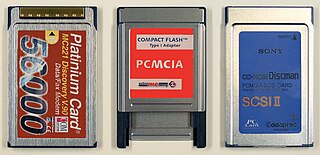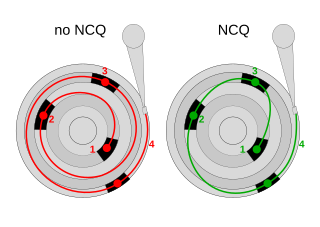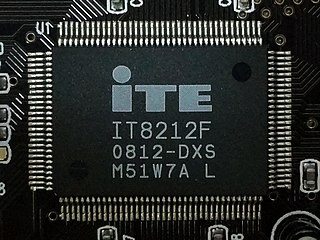
Parallel ATA (PATA), originally AT Attachment, also known as IDE, is a standard interface designed for IBM PC-compatible computers. It was first developed by Western Digital and Compaq in 1986 for compatible hard drives and CD or DVD drives. The connection is used for storage devices such as hard disk drives, floppy disk drives, optical disc drives, and tape drives in computers.

A hard disk drive (HDD), hard disk, hard drive, or fixed disk, is an electro-mechanical data storage device that stores and retrieves digital data using magnetic storage with one or more rigid rapidly rotating platters coated with magnetic material. The platters are paired with magnetic heads, usually arranged on a moving actuator arm, which read and write data to the platter surfaces. Data is accessed in a random-access manner, meaning that individual blocks of data can be stored and retrieved in any order. HDDs are a type of non-volatile storage, retaining stored data when powered off. Modern HDDs are typically in the form of a small rectangular box.

Industry Standard Architecture (ISA) is the 16-bit internal bus of IBM PC/AT and similar computers based on the Intel 80286 and its immediate successors during the 1980s. The bus was (largely) backward compatible with the 8-bit bus of the 8088-based IBM PC, including the IBM PC/XT as well as IBM PC compatibles.

Small Computer System Interface is a set of standards for physically connecting and transferring data between computers and peripheral devices, best known for its use with storage devices such as hard disk drives. SCSI was introduced in the 1980s and has seen widespread use on servers and high-end workstations, with new SCSI standards being published as recently as SAS-4 in 2017.
Direct memory access (DMA) is a feature of computer systems that allows certain hardware subsystems to access main system memory independently of the central processing unit (CPU).

PC Card is a parallel peripheral interface for laptop computers and PDAs.

SATA is a computer bus interface that connects host bus adapters to mass storage devices such as hard disk drives, optical drives, and solid-state drives. Serial ATA succeeded the earlier Parallel ATA (PATA) standard to become the predominant interface for storage devices.

CompactFlash (CF) is a flash memory mass storage device used mainly in portable electronic devices. The format was specified and the devices were first manufactured by SanDisk in 1994.
Programmed input–output is a method of data transmission, via input/output (I/O), between a central processing unit (CPU) and a peripheral device, such as a Parallel ATA storage device. Each data item transfer is initiated by an instruction in the program, involving the CPU for every transaction. In contrast, in direct memory access (DMA) operations, the CPU is uninvolved in the data transfer.

IEEE 1284 is a standard that defines bi-directional parallel communications between computers and other devices. It was originally developed in the 1970s by Centronics, and was widely known as the Centronics port, both before and after its IEEE standardization.

A disk enclosure is a specialized casing designed to hold and power hard disk drives or solid state drives while providing a mechanism to allow them to communicate to one or more separate computers.

In computing, Native Command Queuing (NCQ) is an extension of the Serial ATA protocol allowing hard disk drives to internally optimize the order in which received read and write commands are executed. This can reduce the amount of unnecessary drive head movement, resulting in increased performance for workloads where multiple simultaneous read/write requests are outstanding, most often occurring in server-type applications.
A SCSI connector is used to connect computer parts that use a system called SCSI to communicate with each other. Generally, two connectors, designated male and female, plug together to form a connection which allows two components, such as a computer and a disk drive, to communicate with each other. SCSI connectors can be electrical connectors or optical connectors. There have been a large variety of SCSI connectors in use at one time or another in the computer industry. Twenty-five years of evolution and three major revisions of the standards resulted in requirements for Parallel SCSI connectors that could handle an 8, 16 or 32 bit wide bus running at 5, 10 or 20 megatransfer/s, with conventional or differential signaling. Serial SCSI added another three transport types, each with one or more connector types. Manufacturers have frequently chosen connectors based on factors of size, cost, or convenience at the expense of compatibility.

Parallel SCSI is the earliest of the interface implementations in the SCSI family. SPI is a parallel bus; there is one set of electrical connections stretching from one end of the SCSI bus to the other. A SCSI device attaches to the bus but does not interrupt it. Both ends of the bus must be terminated.
Tagged Command Queuing (TCQ) is a technology built into certain ATA and SCSI hard drives. It allows the operating system to send multiple read and write requests to a hard drive. ATA TCQ is not identical in function to the more efficient Native Command Queuing (NCQ) used by SATA drives. SCSI TCQ does not suffer from the same limitations as ATA TCQ.
HyperDrive (HD) is a series of RAM-based solid-state drives invented by Accelerated Logic B.V. employee Pascal Bancsi, who partnered with the British company HyperOs Systems, who manufactured the retail product. The HyperDrive interfaces with and is recognized by computer systems as a standard hard drive.

The IT8212, or more correctly the IT8212F, is a low-end Parallel ATA controller designed by ITE Tech. Depending on the implemented BIOS and configuration the IT8212F functions in either a RAID or an ATAPI mode, supporting up to four devices using dual channels. The raid mode only supports IDE Hard Disk Drives and includes RAID 0, RAID 1, Raid 0+1 and JBOD, along with a "normal" mode that essentially acts as a standard Hard Disk controller. Optical disk drives such as CD-ROM and DVD drives are supported by the ATAPI mode, which also supports Hard Disk Drives at the loss of all RAID functions. RAID functions are implemented by an embedded microprocessor, thus is not a so-called "Soft raid" controller.
The Word DMA (WDMA) interface was the fastest method used to transfer data between the computer and an ATA device until Ultra Direct Memory Access (UDMA) was implemented. Single/Multiword DMA took over from Programmed input/output (PIO) as the choice of interface between ATA devices and the computer. The WDMA interface is grouped into different modes.

IEEE 1394 is an interface standard for a serial bus for high-speed communications and isochronous real-time data transfer. It was developed in the late 1980s and early 1990s by Apple in cooperation with a number of companies, primarily Sony and Panasonic. It is most commonly known by the name FireWire (Apple), though other brand names exist such as i.LINK (Sony), and Lynx.
Hard disk drives are accessed over one of a number of bus types, including parallel ATA, Serial ATA (SATA), SCSI, Serial Attached SCSI (SAS), and Fibre Channel. Bridge circuitry is sometimes used to connect hard disk drives to buses with which they cannot communicate natively, such as IEEE 1394, USB, SCSI, NVMe and Thunderbolt.













